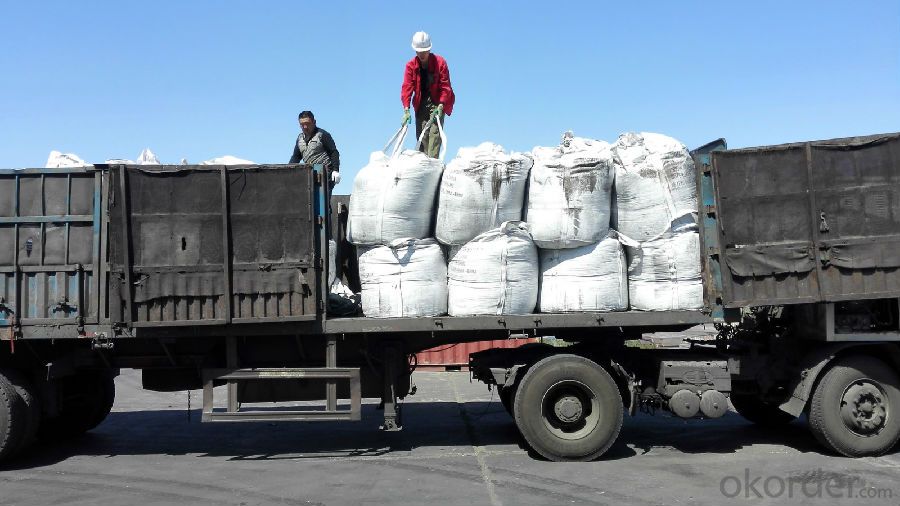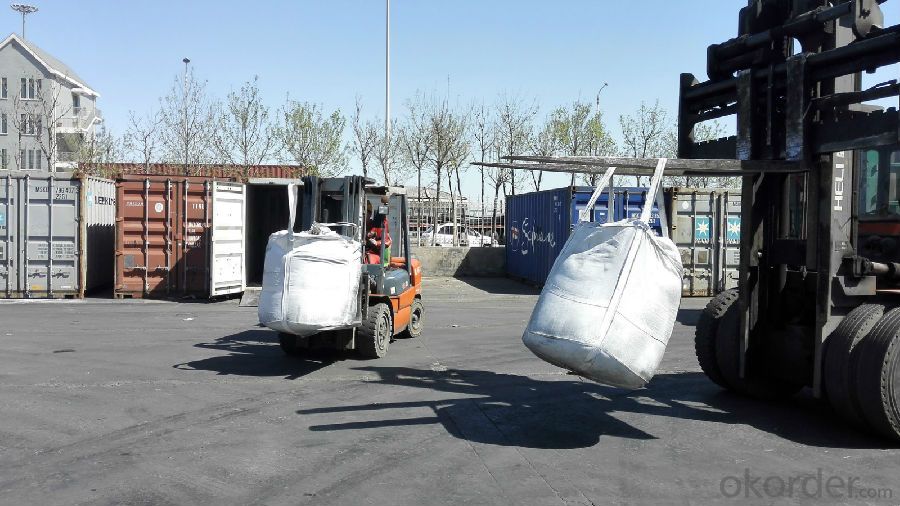China Calcined anthracite as carbon additive for steel plant
- Loading Port:
- Tianjin
- Payment Terms:
- TT OR LC
- Min Order Qty:
- 20.8
- Supply Capability:
- 1008 m.t./month
OKorder Service Pledge
OKorder Financial Service
You Might Also Like
Introduction:
Calcined anthracite can be called carbon additive, carbon raiser, recarburizer, injection coke, charging coke, gas calcined anthracite.It is playing more and more important role in the industry
Best quality Anthracite as raw materials through high temperature calcined at over 2000℃ by the DC electric calciner with results in eliminating the moisture and volatile matter from Anthracite efficiently, improving the density and the electric conductivity and strengthening the mechanical strength and anti-oxidation. It has good characteristics with low ash, low resistivity, low sulphur, high carbon and high density. It is the best material for high quality carbon products. It is used as carbon additive in steel industry or fuel.
Features:
G-High Calcined Anthracite is produced when Anthracite is calcined under the temperature of 1240°C in vertical shaft furnaces. G-High Calcined Anthracite is mainly used in electric steel ovens, water filtering, rust removal in shipbuilding and production of carbon material. It is playing more and more important role in the industry
Specifications:
F.C.% | 95MIN | 94MIN | 93MIN | 92MIN | 90MIN | 85MIN | 84MIN |
ASH % | 4MAX | 5MAX | 6 MAX | 6.5MAX | 8.5MAX | 12MAX | 13MAX |
V.M.% | 1 MAX | 1MAX | 1.0MAX | 1.5MAX | 1.5MAX | 3 MAX | 3 MAX |
SULFUR % | 0.3MAX | 0.3MAX | 0.3MAX | 0.35MAX | 0.35MAX | 0.5MAX | 0.5MAX |
MOISTURE % | 0.5MAX | 0.5MAX | 0.5MAX | 0.5MAX | 0.5MAX | 1MAX | 1MAX |
Pictures




FAQ:
Packing:
(1). Waterproof jumbo bags: 800kgs~1100kgs/ bag according to different grain sizes;
(2). Waterproof PP woven bags / Paper bags: 5kg / 7.5kg / 12.5kg / 20kg / 25kg / 30kg / 50kg small bags;
(3). Small bags into jumbo bags: waterproof PP woven bags / paper bags in 800kg ~1100kg jumbo bags.
Payment terms
20% down payment and 80% against copy of B/L.
Workable LC at sight,
- Q:How does carbon dioxide affect the pH of soil?
- Soil pH can be influenced by carbon dioxide through a process known as carbonation. When carbon dioxide dissolves in water, it creates a weak acid called carbonic acid (H2CO3). This acid can react with certain minerals and compounds, such as limestone or calcium carbonate, found in the soil, causing them to dissolve. As a result, positively charged ions like calcium (Ca2+) or magnesium (Mg2+) are released into the soil solution, which can raise the pH or make the soil more alkaline. Moreover, the presence of carbonic acid can also increase the availability of specific nutrients in the soil. For instance, it can enhance the solubility of phosphorus, making it easier for plants to absorb. This can ultimately improve soil fertility. However, it's important to consider that the impact of carbon dioxide on soil pH can vary due to different factors, including the concentration of carbon dioxide, soil type, and the presence of buffering agents. In some cases, the soil's buffering capacity can limit the effects of carbonic acid on pH changes. Therefore, while carbon dioxide can influence soil pH, it is just one of many factors that can affect the overall acidity or alkalinity of the soil.
- Q:How does carbon impact the availability of natural resources?
- The availability of natural resources is significantly impacted by carbon dioxide (CO2), which is a form of carbon. When fossil fuels like coal, oil, and natural gas are burned, they release large amounts of CO2 into the atmosphere. This excessive release of CO2 is responsible for the greenhouse effect, which leads to global warming and climate change. Climate change has a major effect on natural habitats and ecosystems. It directly affects the availability of various natural resources by causing rising temperatures and changing weather patterns. For example, higher temperatures can result in the melting of glaciers and ice caps, which affects the availability of freshwater resources for human consumption and agriculture. Furthermore, carbon emissions contribute to the acidification of oceans, which harms marine life. Coral reefs, for instance, are highly sensitive to changes in water chemistry. Increased acidity due to elevated CO2 levels can bleach and eventually kill coral reefs. This not only impacts ocean biodiversity but also affects the availability of fish and other seafood resources that many communities depend on. Moreover, climate change caused by carbon emissions disrupts ecosystems and leads to the extinction or displacement of numerous plant and animal species. This has cascading effects on the availability of resources like timber, medicinal plants, and other valuable natural products sourced from forests and other ecosystems. In addition, carbon emissions contribute to air pollution, which has adverse effects on human health. High concentrations of airborne pollutants, including particulate matter, can cause respiratory diseases and other health issues. This strains healthcare systems and reduces the productivity and overall well-being of communities. To mitigate the negative impacts of carbon emissions on the availability of natural resources, it is crucial to transition to cleaner and more sustainable energy sources, such as renewable energy. This shift would reduce reliance on fossil fuels and subsequently decrease carbon emissions, thus helping preserve and protect our natural resources for future generations.
- Q:I just decoration, do not understand, JS run, please feel free to show.
- LED gold tube Yuba, tinghuo... Carbon fiber was a real fire last year
- Q:Recently bought an alarm clock, it is recommended to use carbon batteries. Nanfu battery is not good for the movement.
- Yes, a lot of people do not pay attention to, the Nanfu battery, strange carbon batteries say it is really rare, generally small supermarkets are not only basic, and is strongly alkaline. Therefore, it is best to go to a large supermarket or electrical store try, there are generally sold there, and many types, the choice will be more.
- Q:How do you stick carbon fabric?
- 1 、 construction tools and equipmentThe main equipment includes cutting machine, angle grinder and roller brush2, concrete substrate treatment(1) remove the damaged parts and damaged parts of the concrete parts and reach the compacted parts(2) check whether exposed steel bars are rusted or not. If there is rust, the necessary treatment should be carried out(3) repair the damaged part of the component through the chisel, the cleaning and the exposed ribs, and then use the epoxy mortar, which is higher than the strength of the original component concrete, to repair and restore to the surface(4) crack repair. Cracks with a width of less than 0.20mm shall be coated with epoxy resin and sealed. Cracks greater than or equal to 0.20mm shall be sewed with epoxy resin(5) to the designated location, scope of patch repair and reinforcement of ink, according to the design requirements.(6) burnish the surface of the member (the connecting part of the concrete component, the difference of the section of the template), and make sure that the repaired section is as smooth as possible(7) the angular position, with grinder. Rounding radius should be larger than 30mm, the minimum of not less than 20mm.
- Q:How is carbon used in water filtration systems?
- Carbon is used in water filtration systems as a filter medium or adsorbent. It effectively removes impurities, such as chlorine, volatile organic compounds (VOCs), and other contaminants, by adsorbing them onto its porous surface. This process helps improve the taste, odor, and overall quality of drinking water.
- Q:What is the atomic number of carbon?
- Carbon has an atomic number of 6.
- Q:What is carbon black rubber?
- Carbon black rubber is a type of rubber that contains carbon black as an additive. Carbon black is a finely divided form of carbon, produced by the incomplete combustion of hydrocarbon fuels. It is added to rubber compounds to improve its mechanical properties, such as tensile strength, abrasion resistance, and resilience. The carbon black particles are dispersed within the rubber matrix, providing reinforcement and enhancing its durability and performance. Carbon black rubber is commonly used in the production of tires, conveyor belts, gaskets, seals, and various automotive and industrial rubber products.
- Q:What is the carbon content of different fuels?
- The carbon content of various fuels can differ greatly based on their composition and source. However, fossil fuels like coal, oil, and natural gas generally contain high levels of carbon. Coal, predominantly carbon-based, typically contains approximately 60-80% carbon. This makes it a highly carbon-intensive fuel and a significant contributor to greenhouse gas emissions when burned. Crude oil and petroleum products, such as gasoline and diesel, also possess substantial carbon content, ranging from 80-90%. When these fuels are burned, they release significant amounts of carbon dioxide (CO2) into the atmosphere. In comparison, natural gas, primarily composed of methane (CH4), has a lower carbon content than coal and oil. Methane itself consists of one carbon atom and four hydrogen atoms, resulting in a carbon content of about 75%. Although natural gas emits less CO2 when burned compared to coal and oil, methane itself is a potent greenhouse gas that can contribute to climate change. Renewable fuels, like biofuels, display varying carbon contents based on their origin. Biofuels are derived from organic materials, such as plants and agricultural waste, and can have carbon contents similar to fossil fuels. However, since biofuels are obtained from recently living organisms, the carbon dioxide emitted during their combustion is considered part of the natural carbon cycle and does not contribute to long-term increases in atmospheric CO2 levels. In summary, the carbon content of different fuels plays a critical role in determining their environmental impact and contribution to climate change. The transition to low-carbon or carbon-neutral fuels is essential in reducing greenhouse gas emissions and mitigating the effects of climate change.
- Q:What are the differences between the three carburizing, nitriding and carbonitriding? What are the different effects on the material?
- Carburizing: carburized workpiece after quenching and low temperature tempering, so that the surface has a high hardness of river abrasion resistance, and the heart still maintain a good plastic River toughness, so as to meet the workpiece outside the hard, internal use of tough requirementsNitriding: after the nitriding of the parts, the surface forms a nitride.
1. Manufacturer Overview |
|
|---|---|
| Location | |
| Year Established | |
| Annual Output Value | |
| Main Markets | |
| Company Certifications | |
2. Manufacturer Certificates |
|
|---|---|
| a) Certification Name | |
| Range | |
| Reference | |
| Validity Period | |
3. Manufacturer Capability |
|
|---|---|
| a)Trade Capacity | |
| Nearest Port | |
| Export Percentage | |
| No.of Employees in Trade Department | |
| Language Spoken: | |
| b)Factory Information | |
| Factory Size: | |
| No. of Production Lines | |
| Contract Manufacturing | |
| Product Price Range | |
Send your message to us
China Calcined anthracite as carbon additive for steel plant
- Loading Port:
- Tianjin
- Payment Terms:
- TT OR LC
- Min Order Qty:
- 20.8
- Supply Capability:
- 1008 m.t./month
OKorder Service Pledge
OKorder Financial Service
Similar products
New products
Hot products




























